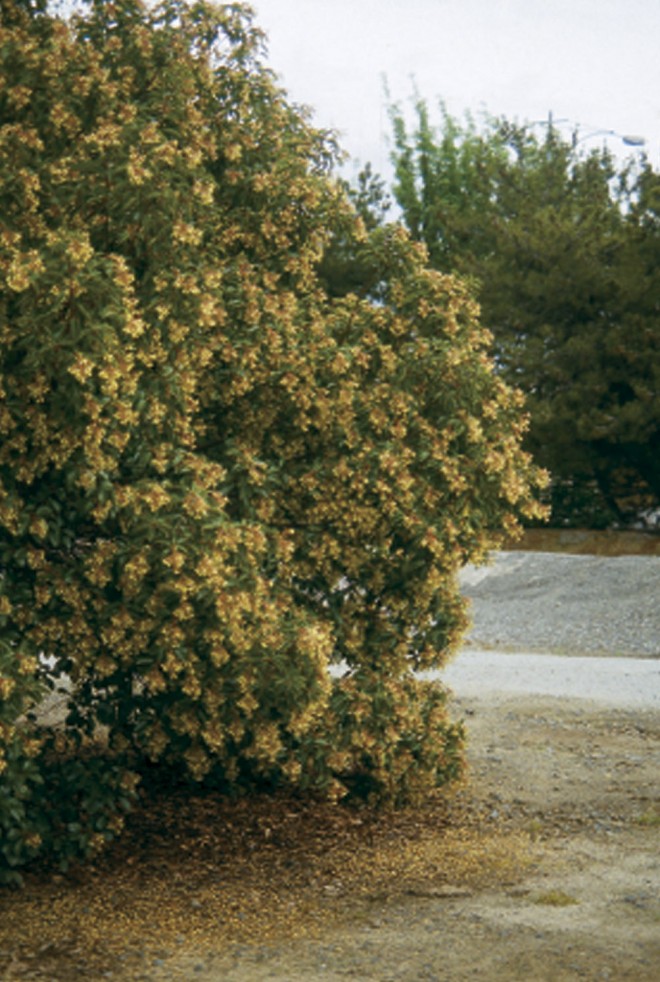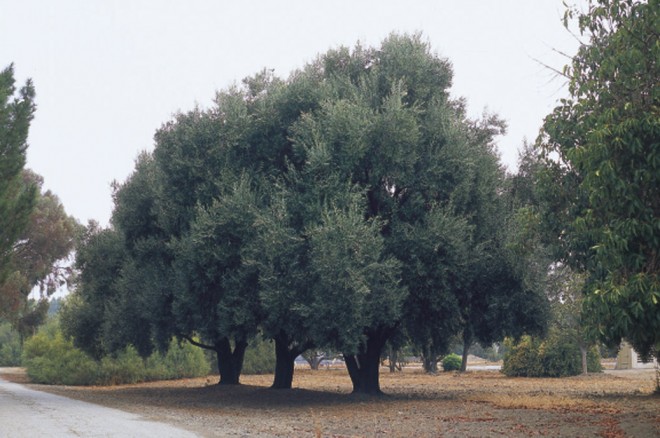
An Unknown Tree Research Site in Santa Clara Valley

Contributor

As commuters speed along one of Silicon Valley’s major arterials, most would probably be surprised to know they were passing one of the West’s hidden plant treasures, an early test ground for the Saratoga Horticultural Foundation (SHF). In 1963, “Saratoga Hort,” as everyone called it (the full name was too large a syllabic mouthful), began planting a test site that would eventually contain over 180 kinds of plants new to mid-California. The foundation began its twenty-year trial with the installation of a broad range of interesting new plants on the southern half of the approximately seven-acre property, along with a number of experimental cultivars of coast redwood (Sequoia sempervirens) planted as a screen along the freeway boundary.
George Martin, a Los Gatos landscape architect and member of Saratoga Hort’s board of directors, arranged with one of his clients, the San Jose Water Company, for the foundation to use one of their pumping stations as a horticultural test plot. Today, many of the survivors of this noble experiment are living and thriving on this undistinguished urban acreage. Here, trees and shrubs announce by their persistence that they, too, can be added to the landscape industry’s list of “work horses.”
Barrie Coate was a young plant fanatic when he began his horticultural career at the foundation. He had fallen into a tree-lovers paradise! A propagator at the San Jose site’s start, he was fortunate to be one of the diggers-of-holes for this wonderful collection of little-known plants.

He and other foundation staff planted and then hand watered the plants through their first season, after which the plants were left on their own, fully dependent upon the natural winter rains (when they came), and subjected to the heat and dryness of San Jose summers (Sunset zone 14, USDA hardiness zone 9). The water company provided weed control, which was and still is managed primarily by a tractor- towed disc between the plantings.
Plantings at the site continued intermittently through 1982, when a major installation filled the northern half of the site.
During a review of the site early in 2005, Barrie and his assistant, Peter, were able to identify a considerable number of the plants from the original installations that are now between twenty-three and forty-three years old. These time spans allow a current observer to see which species had the capacity to survive the dry environment, to evaluate the presence and severity of pests, and to identify the handsomest survivors.

The Survivors
The early plantings included several species of eucalyptus that have never become common in the nursery trade, although their survival at this project site suggests great value for the California landscape. The survivors include Eucalyptus baueriana, E. dwyeri, E. eudesmoides, E. maculosa, and E. pauciflora. Angophora melan-oxylon, a close relative of eucalyptus (eucalyptus leaves are alternate; angophora are opposite), was so successful that most of the six original trees have survived and are now fifty feet tall with fortyfoot-wide canopies.
The foundation planted several specimens of Fraxinus angustifolia (syn. F. oxycarpa) from Southern Europe to provide seed to produce rootstock for the new Raywood ash (F. oxycarpa ‘Raywood’) that George Martin had just brought back from Australia. At the time, Saratoga Hort was the only seed source, so other nurseries that wanted to grow Raywood ash had to get their seeds from the foundation; this provided an additional income source for the perpetually struggling nonprofit foundation.
In 1972, the fastigiate form of European hornbeam (Carpinus betulus fastigiata) was planted here and, since then, has become one of the hottest “new” plants in California, with landscape architects using them in situations as diverse as “exclamation points” in shopping center parking lots to sheared hedges in formal estate gardens. At the San Jose site, however, they continue to thrive with far less attention than at their other landscape settings.
One of the real stars at the site is a dwarf form of Olea europaea subsp. africana. After thirty years with no pruning, irrigation, or fertilizing, the five original plants are identical to each other: four feet tall, five feet wide, perfectly round balls, densely foliaged with dull green, one-and-a-half-inch-long leaves.
Another test plant from 1972 was the fruitless ‘Swan Hill’ olive (Olea europaea ‘Swan Hill’). Hudson Hartman, a professor at UC Davis, brought this plant back from Adelaide, Australia; subsequent cuttinggrown plants would become the property of the University of California. The difficulty in propagating ‘Swan Hill’ from cuttings, combined with the inability of the university’s legal department to agree upon rights for potential growers, resulted in a delay of many years before someone solved both problems and it entered the nursery trade. Three of the first plants were given to Saratoga Hort to be planted at the San Jose test plot; today, they are twenty-eight feet tall by twenty feet wide and remain the most handsome olives in the county.

As soon as the US National Arboretum introduced the evergreen Viburnum x rhytidophylloides ‘Allegheny’, five were planted at the site. All five survived for many years in excellent health, in spite of the droughts of the 1970s. The eight-inch-long rugose leaves of the V. rhytidophyllum parent are striking, but the growth habit of ‘Allegheny’ is much more dense than that of either parent species. Monrovia Nursery ultimately offered this large shrub, but sales have never been good. What a shame, given its success under these trying conditions.

When seed of Afghan pine (Pinus brutia subsp. eldarica) was brought back from that country by a team of botanists in the mid-1960s, two of the resulting trees were planted here. They astounded everyone with their annual three-foot growth, in spite of regular infestations at each branch cluster by sequoia pitch moths (Synanthedon sequoiae). The pines are still alive, but not the handsomest of specimens.
Afghan pistache (Pistacia chinensis subsp. integerrima) was planted in 1973. This tree produces red juvenile foliage all summer and develops a brilliant red fall color. Extremely drought tolerant, it has a much better branching structure than the more common Chinese pistache (P. chinensis). The city of Modesto has now patented a selection of Afghan pistache.
Arbutus x andrachnoides, a natural hybrid between strawberry tree (A. unedo) and its Grecian cousin, A. andrachne, was planted at the site in 1963. The plant survives as a small tree, ten feet tall and fifteen feet wide, with elegant, light grey bark that peels like our native madrone (A. menziesii). The pendant clusters of creamy white, half-inch bells are typical of the genus.
Has anyone heard of Euclea pseudebenus? Most guess this is a shrubby form of Chilean mayten (Maytenus boaria). None of the common references list the plant, but it is thought to be from South Africa. The small, narrow green leaves are borne on long arching branches to twelve feet tall. It has survived the challenges of the site in excellent condition.

The Failures
It must be admitted that not everything planted was successful, but that was not the goal, nor the expectation of this research site. Among the many in the “deserving but failed” column are:
- pencil willow (Salix chilensis fastigiata)
- wine palm (Jubaea chilensis)
- mescal bean (Sophora secundiflora)
- southern beech (two species of Nothofagus from New Zealand)
- Oriental sycamore (Platanus orientalis)
- striped-bark maples (Acer crataegifolium, A. davidi, and A. capillipes all failed, but A. morrisonense is in reasonably good health)
All of these observations offer priceless information for the horticulturist in the West today. Though it would be ideal to allow interested individuals to tour the trial grounds, the water company now must consider the site a high security location, and entrance is highly restricted.

You May Like to Know
The Saratoga Horticultural Research (added to its name later) Foundation closed its San Martin, California, offices and growing facility in August, 2004, after the board determined that its functioning was no longer financially viable.
Since then, the board of directors has been meeting regularly (in Saratoga) to determine how best to keep the name and goals of the foundation alive in the Western horticultural community. By the time this is published, the plans for establishment of the Saratoga Horticultural Research Foundation Endowment should be finalized. Stay tuned for more news soon.
Additional articles about Saratoga Hort’s history and its contributions to Western landscapes will appear in future issues of Pacific Horticulture.
Share:
Social Media
Garden Futurist Podcast
Most Popular
Videos
Topics
Related Posts

Ground Up Science for Greener Cities with Garden Futurist Dr. Alessandro Ossola
Spring 2023 Listen to the Podcast here. Alessandro Ossola is a scientist who gets very excited about the challenge of climate change allowing for an

Readying Urban Forests for Climate Realities with Garden Futurist Dr. Greg McPherson
Winter 2023 Listen to the Podcast here. “Going from the mow and blow to a more horticulturally knowledgeable approach to maintaining the landscape. And that

Welcome, Greywater, to the Garden
Summer 2022 Oh, summer: delightful warm air, tomatoes swelling on the vine, fragrant blooms on an evening stroll. When it’s warm and rainless, how is

Big Tree-Data and Big-Tree Data with Garden Futurist Matt Ritter
Summer 2022 Listen to the full Garden Futurist: Episode XV podcast here. We are in an environmental crisis right now in many parts of California










Responses